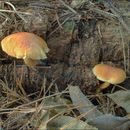en
names in breadcrumbs


Guidance for identification (German text)
Pholiota astragalina is a species of fungus in the family Strophariaceae. It was first described scientifically in 1821 by Elias Magnus Fries as a species of Agaricus. Rolf Singer transferred it to the genus Pholiota in 1951.[2] The fruitbodies of the fungus have pinkish-orange caps measuring 2–5.5 cm (3⁄4–2+1⁄8 in) in diameter. The flesh is orange, blackening in age, with a bitter taste.[3] They produce a reddish-brown spore print, causing it to be placed in its genus rather than Hypholoma, which it resembles.[3] The spores are oval to elliptical, smooth with thin walls, and measure 5–7 by 4–4.5 µm. In North America, the fungus is found in the United States and Canada. In Europe, it has been recorded from France, Sweden, and Switzerland.[4] Its mushrooms usually grow singly or in small clusters, sometimes on conifer logs.[3]
Though nonpoisonous,[5] the species is regarded as inedible.[6]
Pholiota astragalina is a species of fungus in the family Strophariaceae. It was first described scientifically in 1821 by Elias Magnus Fries as a species of Agaricus. Rolf Singer transferred it to the genus Pholiota in 1951. The fruitbodies of the fungus have pinkish-orange caps measuring 2–5.5 cm (3⁄4–2+1⁄8 in) in diameter. The flesh is orange, blackening in age, with a bitter taste. They produce a reddish-brown spore print, causing it to be placed in its genus rather than Hypholoma, which it resembles. The spores are oval to elliptical, smooth with thin walls, and measure 5–7 by 4–4.5 µm. In North America, the fungus is found in the United States and Canada. In Europe, it has been recorded from France, Sweden, and Switzerland. Its mushrooms usually grow singly or in small clusters, sometimes on conifer logs.
Though nonpoisonous, the species is regarded as inedible.